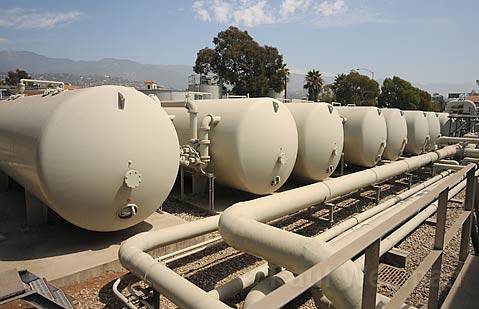Pulling the $53 Million Desal Trigger
'We Have Exhausted All Other Options,' Says Water Czar

Even with unprecedented unanimity among meteorological experts that a powerful El Niño looms ahead, not one Santa Barbara city councilmember felt they could risk another year without rain. Backed into an ominously parched corner by the most intense drought in California’s recorded history — and with new deliveries from Lake Cachuma and the State Water Project effectively shut off — the council voted to reactivate the desalination plant it built 25 years ago as an emergency response to the last big drought. No sooner was that plant built than the South Coast was pummeled by the “Miracle March Rains,” and Santa Barbara’s desal facility has sat idle since.
That history was very much on the councilmembers’ minds as they approved spending nearly $4 million for a rebuilt and reengineered desalination plant that will eventually cost city ratepayers $53 million. “If Mother Nature wanted to tell us what her plans were, we’d all sleep easier,” lamented Mayor Helene Schneider, “but she doesn’t.” Water czar Joshua Haggmark likewise had little interest in betting whether the predicted El Niño would deliver relief needed to replenish South Coast reservoirs. In the six El Niños in recorded history, Haggmark told the council, only three brought above-average rainfall. “It’s still a significant unknown,” he said. “We have exhausted all other options.”
The bad news is that the proposed desalination plant the councilmembers are now looking at will cost about $14 million more than they thought it would just a few months ago. And that’s about $35 million more than it was projected to cost two years before that. (The plant originally cost $34 million to build.) The good news is that the State of California is offering to finance the whole enterprise with bargain basement interest rates of only 1.6 percent. Thanks to the low-interest loans, the annualized cost of building and operating the plant for five years is $7.3 million.
The consultant selected by City Hall to rebuild the facility is IDE Americas USA, whose parent company has been involved in the construction of 400 desalination plants in 40 countries, including the biggest one on the planet — in Israel — not to mention the biggest in the United States — in Carlsbad, California. One reason the costs jumped is that IDE wanted to build new structures rather than refurbishing existing ones. Company CEO Mark Lambert introduced himself to the council stating, “We’re here to help. It’s what we do. All we do is desalination.”
The plant will be built to produce 3,125 acre-feet of water a year, roughly 25 percent of what city residents consume. IDE got the nod partially because of the “modularity” of its proposal. For an additional $20 million, the plant could be ratcheted up to 7,500 acre-feet. And for a sum unknown, it could achieve a maximum capacity of 10,000 acre-feet a year.
When Santa Barbara secured crucial state permit renewals earlier this year, it was as a preexisting facility that would serve only city water customers. But now — well before final designs have been drafted — the talk is shifting to running the plant as a regional facility. Tom Mosby of the Montecito Water District said he was assured by senior staff with the Regional Water Quality Control Board and the California Coastal Commission they’d prefer Santa Barbara’s facility operate regionally than see the Montecito district pursue its own desalination plant, as it currently is. There was an abundance of confusion displayed at Tuesday’s council meeting on how much of this would be acceptable with the city’s existing permits.
Kira Redmond of Channelkeeper raised pointed questions about the environmental analysis City Hall provided. She noted the 471-page document was released only three business days before Tuesday’s council meeting and objected that the analysis was based on reports originally prepared in 1991 and 1994. Given how much technology has evolved since, she said those reports finding no adverse impacts to the marine environment would be dismissed as “quackery” today. One study, she noted, erroneously assumed the desal plant’s intake valves would suck in 18 times less water than they actually will.
Redmond has unsuccessfully pushed City Hall to adopt more modern water-intake technology to minimize damage to microscopic aquatic life and larvae. When asked after the meeting if she intended to sue, Redmond said, “I don’t think so. But I wanted it read into the record that they’re not complying with the law.”
On the same day, the Goleta Water Board voted to adopt higher water rates in part to encourage more vigorous conservation and also to recoup the substantial loss in revenues such conservation generates. For the residential customers who cut back accordingly, average monthly water bills will remain about the same — $112. But for farmers, who make up one percent of the customer population and account for 30 percent of all water sales, the rates will skyrocket from an average of $919 a month to $2,400. For those operating outside the urban envelope on the western edge of the valley, their bills go up even more, from $3,500 a month to $10,000. She called the matter a local issue. Nearly 80 farmers and two agricultural organizations weighed in against the rate hikes, arguing they would effectively end agriculture in the Goleta Valley.
Dave Matson of the Goleta Water District said the rates were necessary because agricultural use had increased in the past two years, and, he said, “There is only so much water left.” Matson said the district is trying to offset some of the economic pain by offering ag operators rebates for buying new, efficient irrigation system.



